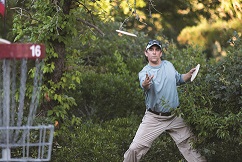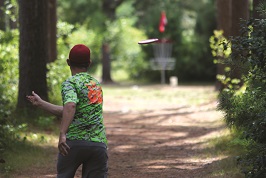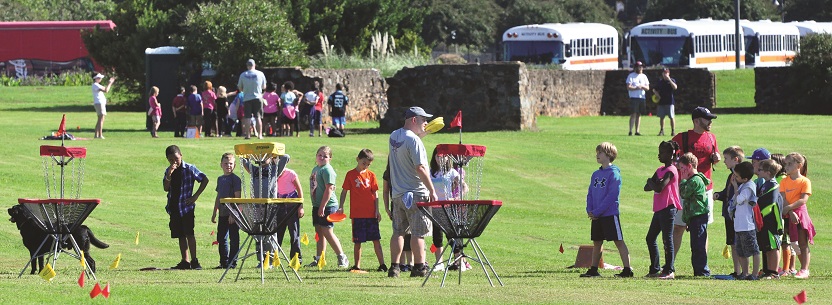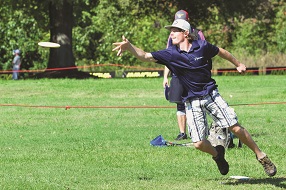
Editor's Note: Most times when you hear a sport is struggling, it isn’t good news. In the case of the Professional Disc Golf Association (PDGA), the international governing body for the sport of disc golf, the struggle means the staff’s work to keep up with what executive director Brian J. Graham refers to as “the massive growth of the sport.” There’s even more good news: the World Flying Disc Federation (WFDF), the overall governing body of disc sports, has succeeded in obtaining recognition at the Olympic level for disc sports. And for those who like their sports trivia, here’s a nice piece: the record for distance in a disc throw is held by a pro disc golf player, and it’s 863-1/2 feet, which is the length of about three football fields laid end to end.

Advantages of Disc Golf
There are a lot of reasons the sport is booming. One is the fact that it’s inexpensive to take up. You really only need one disc as a beginner, and you can buy it almost anywhere for about $15. If you want to buy putting baskets or other equipment, you can usually find them in big-box stores. Disc golf also uses a skill people are already comfortable with; almost everyone has thrown a Frisbee at least once, and almost everyone thinks they can do it well. Not a lot of other sports can say that.
Something else disc golf has in its favor is that once you get your disc, it is usually free to play. You don’t have to pay greens fees or rent a cart; you can just go to a park that has a disc golf course and get started. It’s awesome for families to do together, or for a group of friends, or you can just go by yourself. It’s also a workout that is similar to hiking because you may be going up and down hills and through some challenging terrain where you’re trying to throw the disc around trees and other objects. That’s another reason the sport has grown: people like being outdoors.
 Availability of Courses
Availability of Courses
Years ago, it might have been difficult to find disc golf courses in cities, but today, they’re everywhere, which is an indicator of the sport’s growth. Parks love putting in disc golf because while it’s a minimal investment on their part – maybe as little as $25,000 – it brings in people. In fact, when we first started, we would talk to cities and convince them to put in a disc golf course in a park, and they would designate land they couldn’t use for athletic fields or anything else because it was too wooded, too hilly, too rocky, or maybe it just wasn’t in a great area.
Something the cities would see, though, was that once they put in a disc golf course, it brought in a lot of people. That extra foot traffic in the park got rid of a lot of undesirable activity. Plus, disc golfers are actually very environmentally conscious and they would pick up trash as they played. Gradually, parks started noticing that when you put in disc golf courses, it actually improved the area. We’d hear that time and time again, about disc golf really cleaning up the parks system. And for us, rocky or wooded land just makes the course more challenging and interesting. It’s a lot more fun to have to throw a disc around trees and bushes in order to advance to the next hole than it is to throw in a flat, open field.
As another example of the growth of the sport, the PDGA has an online course directory, and you can search by city, state, country, etc., to find places to play. The course directory literally changes every day because new courses are going in all the time. We had about 5,000 disc golf courses listed by the end of 2014. There are easily 6,000 to 7,000 courses today. There are even indoor training facilities, and in Kentucky, there is a cave system with an underground disc golf course.
 Disc Golf vs. Traditional Golf
Disc Golf vs. Traditional Golf
People often ask what disc golf has in common with traditional golf – and they’re usually amazed when they find out how close the two really are. They share the same rules, the same etiquette, the same terms and the same emphasis on strategy.
In traditional golf, you choose your club because you need a certain amount of loft or distance in a shot. You choose your discs the same way. Some are for the longer shots, some are for putting, some curve left when they’re thrown and some curve right. In fact, the pros will have competition bags they carry around with 10 to 20 discs, each for a different shot.
While the golf industry is in decline, disc golf is booming. In fact, we’re seeing a lot of traditional golf courses adding disc golf and foot golf so that everyone is playing at once. One side of the fairway will be set up for disc golf and the other side will be set up for foot golf, with traditional golf down the middle. Financially, it’s good for the course, since it’s bringing in more people to play.
One big difference between disc golf and traditional golf, and one of the reasons disc golf is so popular, is that it’s less time-consuming. A round of disc golf will take about an hour and a half; it doesn’t use up your whole day.
 The Professional Game
The Professional Game
Disc golf has a huge following of people who play recreationally; however, it also has a pro game and a national tour. The PDGA is primarily a sanctioning body, but we also own the biggest disc golf events, the PDGA Amateur Disc World Championships and the PDGA Pro Disc Golf World Championships. Our website has a full list of the major events taking place each year.
We estimate our membership is about 78 percent amateurs and 22 percent professionals. There is a group of touring players who go on the road full-time to compete, and then there are the weekend warriors – similar to just about every other sport. The people who join the PDGA are typically hardcore competitors, but we estimate there are millions of disc golfers around the world.
The Business of Disc Golf
At this point, we don’t really have any hard and fast numbers on spend when our players go to events; that’s just not something we’re tracking right now. We do know PDGA members love to travel, and they love to play different courses. Typically, when they’re traveling on vacation, or even for work, they will find the local disc golf course and play it. There has definitely been an increase in interest from CVBs and sports commissions who want us to bring our competitive events to their cities.
 We also know the sport is booming all over the world. Our membership is primarily in North America, but the sport has exploded outside the U.S. One of the areas that is a hotbed is the Scandinavian countries, such as Finland and Sweden; in fact, there must be 800 courses in Finland alone.
We also know the sport is booming all over the world. Our membership is primarily in North America, but the sport has exploded outside the U.S. One of the areas that is a hotbed is the Scandinavian countries, such as Finland and Sweden; in fact, there must be 800 courses in Finland alone.
The industry of disc golf is also growing. Years ago, when I started playing, hardly anyone had heard of the sport and almost no one had equipment. Now, PDGA works with about 70 different manufacturers and we set the specifications for the equipment used in the game.
PDGA has also noticed an evolution: In the cities where disc golf courses have gone in, local clubs form, and so do leagues. In turn, they attract more players. We see it as part of the growth, and we expect it to continue.

